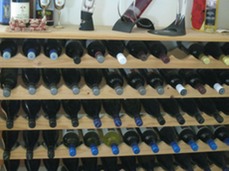
Having looked at the origins of the cleanskin phenomenon, let’s look at some of the other ways a winery can dispose of wine that’s sitting around taking up valuable space.
One way of doing that is to sell the bottle with someone else’s name on it, and it offers the option of selling it at something approaching the regular price if it’s being used to promote a business.
For example, a mate dropped off a bottle of Vintage Port a couple of years back, something he’d received as a Christmas present from a business he’s dealt with for a couple of years. The label identified it as coming from Tamburlaine in the Hunter Valley, and a quick Google revealed that you can order something along the same lines from an independent supplier for around $200/dozen, which is a little further up the market from cleanskin country.
And if you look around you there are plenty of restaurants and hotels that offer their own label wines, which have to come from somewhere. Along similar lines, various distributors in the liquor industry will buy and rebadge wines under their own private label.
Taking one example I’m reasonably familiar with, The Wine Society offers three Society label ranges - easy drinking selections around the $8-9 mark, a regional premium range in the mid- to high-teens and a premium selection above that. They’re all probably a couple of dollars cheaper that their brothers and sisters that sport the winery’s label, but you’d guess this rebadging yields higher returns to the winery than cleanskins do.
Apart from that sort of thing, the various wine clubs around the place also offer an avenue to move excess stock, in some cases significantly below Recommended Retail. A quick glance through the most recent newsletter from The Wine Society reveals a $25 cab merlot for $12.50 and a quality label Coonawarra shiraz not far off half price.
Talking of wine clubs, more and more wineries are either establishing their own or vamping up their mailing list and internet options.
For a start, if you’re a two thousand case small winery and you end up with four hundred club members who take a pre-ordered dozen bottles a year that’s 20% of your production out the door without much trouble with every chance individual customers will reorder things they like.
Under those circumstances, of course, the consumer’s usually paying RRP minus a club discount which may or may not include free freight or at least a substantial subsidy and those sales would go into the winery’s forward planning.
Another avenue medium-scale operations are turning to is, of course, the internet, and anyone who visits their favourite winery’s website would be well advised to make sure they’re signed up for whatever email updates the establishment offers.
Two examples:
At the end of 2006 we visited Tahbilk and, in the course of tasting whatever was on offer (and there’s a substantial range) discovered that their wine club offers freight-free delivery along the eastern seaboard and South Oz and signed up. Admittedly, we signed up for the snail mail newsletter, so it’s costing Tahbilk to send the monthly mag out, but the first issue revealed the existence of the wine club Everyday Drinking label, with the result that over the past two and a bit years there haven’t been many occasions when we’ve been without something sourced from that range.
At $59.40 freight free for a dozen of the 2004 Everyday Drinking Cabernets you can probably see why Hughesy doesn’t buy many cleanskins. Need half a bottle of red for a hearty winter casserole? No prizes for guessing where I’ll be heading, because the rest of the bottle will be quite pleasant quaffing while the broth’s bubbling away.
When I went to reorder for about the twelfth time a week and a half ago I noted a no label clean skin 2008 Classic Dry White on special for $45. They’re pretty quick when it comes to deliveries as well, and when the cartons arrived on Tuesday afternoon the envelope with the credit card chit also contained a slip advising of a Museum Release special offer - 1994 Cabernet Sauvignon $210/dozen.
I was reminded of the benefit of signing up for the email version of a winery’s newsletter earlier this week when my in-box contained an update from Jim Barry Wines in Clare. The price on the Watervale Riesling ($100/dozen) wasn’t as good as the Boxing Day Sale price ($84) but there’s none of that left. They only had seventy cases in stock and I suspect I’d find I’m too late if I were to call. They’ve still got the 2004 Lodge Hill Shiraz at a tenner for a wine where the RRP would be much closer to twenty.
Those are only two examples of the value on offer if you’re looking for something more up market than a cleanskin, and I’m sure to be expounding further in future entries.
Sunday, 17 May 2009